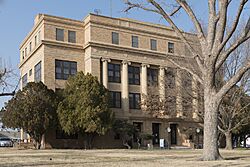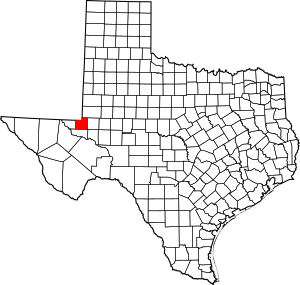Winkler County, Texas facts for kids
Quick facts for kids
Winkler County
|
|
|---|---|

The Winkler County Courthouse in Kermit
|
|

Location within the U.S. state of Texas
|
|
 Texas's location within the U.S. |
|
| Country | |
| State | |
| Founded | 1910 |
| Named for | Clinton McKamy Winkler |
| Seat | Kermit |
| Largest city | Kermit |
| Area | |
| • Total | 841 sq mi (2,180 km2) |
| • Land | 841 sq mi (2,180 km2) |
| • Water | 0.2 sq mi (0.5 km2) 0.02% |
| Population
(2020)
|
|
| • Total | 7,791 |
| • Density | 9.3/sq mi (3.6/km2) |
| Time zone | UTC−6 (Central) |
| • Summer (DST) | UTC−5 (CDT) |
| Congressional district | 23rd |
Winkler County is a county located in the western part of Texas, a state in the United States. In 2020, about 7,791 people lived there. The main town and county seat is Kermit. Winkler County was officially created in 1887 and started operating as a county in 1910. It was named after Clinton McKamy Winkler, who was a colonel in the Confederate Army.
Contents
History of Winkler County
Early People and Explorers
The first people known to live in the Winkler County area were the Anasazi Indians. They arrived around 900 AD. They left behind pieces of pottery, showing they lived there. These early Native Americans liked the area because it had water. They could find water in ponds or by digging shallow wells.
In the mid-1800s, military groups explored the area. Captain Randolph B. Marcy came through in 1849. He was looking for the best wagon route to California. Later, Captain John Pope surveyed the area in 1854. He was looking for a good path to build a railroad.
Ranching and Settlement Begin
In 1875, Colonel William R. Shafter and his soldiers tracked the Comanche Indians into the county. By 1876, the Comanche threat was gone. This opened the land for white settlers.
In 1881, the Texas and Pacific Railway was built nearby. This made it easier to get to the area. With good transportation, lots of grass, and water, the land was perfect for large ranches. Early ranchers included John Avary, J. J. Draper, and the Cowden brothers.
On February 26, 1887, Winkler County was officially formed. It was named after Confederate Colonel Clinton M. Winkler.
Growth and Challenges
By 1890, only 18 people lived in Winkler County. In 1900, the population grew to 60. The state of Texas stopped giving away free land in 1900. They started collecting rent from ranchers.
From 1901 to 1905, a state law allowed people to buy school lands in West Texas. This led to many new settlers coming to Winkler County. They could buy land easily, which caused a "school-land rush."
To help the new residents, a post office opened in Duval in 1908. Duval and Kermit both wanted to be the county seat. Kermit offered free land lots, so residents chose Kermit. Duval then slowly disappeared.
In 1910, Winkler County was officially organized. The population grew to 442 people. Most people were ranchers, raising cattle and sheep. However, a big drought hit in 1916. Many families left their farms. By 1920, only 81 people lived in the county.
The Oil Boom Era
In 1926, the Hendrick oil field was discovered. This changed Winkler County forever. Roy Westbrook, J.P. Johnston, and George B. McCamey found the oil. Soon, many oil wells were producing thousands of barrels of oil each day.
This oil discovery led to a huge population boom. The town of Wink grew quickly. Many new people came to work in the oil fields. There weren't enough homes, so people lived in tents. Several small towns like Tulsa, Brookfield, Cheyenne, and Leck also appeared. But most of these towns did not last long.
By 1930, the county's population jumped to 6,784 because of the oil boom. Ranching continued, but farming almost stopped. The population dropped a bit by 1940.
Later Years and Oil Industry Changes
The population rose again to 10,064 by 1950. In the 1950s, ranching was still very important. The population reached its highest point in 1960, with 13,652 residents.
However, the oil industry in West Texas began to slow down in the 1970s. This caused Winkler County's population to drop to 9,640 by 1970.
In the early 1980s, there was another oil boom. More drilling happened, and new workers moved in. The population rose to 9,944. But then, oil prices fell again. By 1990, the population dropped to 8,626. Most people lived in Kermit or Wink. Winkler County continues to be an important area for oil and ranching.
Geography of Winkler County
Winkler County covers about 841 square miles (2,178 square kilometers). Most of this area is land, with only a tiny bit of water. The weather is usually dry. In spring and summer, it gets very hot. Some of the hottest temperatures in the United States are recorded here.
Neighboring Counties
Winkler County shares borders with several other counties:
- Andrews County (to the northeast)
- Ector County (to the east)
- Ward County (to the south)
- Loving County (to the west)
- Lea County, New Mexico (to the northwest, in a different time zone)
People of Winkler County (Demographics)
| Historical population | |||
|---|---|---|---|
| Census | Pop. | %± | |
| 1890 | 18 | — | |
| 1900 | 60 | 233.3% | |
| 1910 | 442 | 636.7% | |
| 1920 | 81 | −81.7% | |
| 1930 | 6,784 | 8,275.3% | |
| 1940 | 6,141 | −9.5% | |
| 1950 | 10,064 | 63.9% | |
| 1960 | 13,652 | 35.7% | |
| 1970 | 9,640 | −29.4% | |
| 1980 | 9,944 | 3.2% | |
| 1990 | 8,626 | −13.3% | |
| 2000 | 7,173 | −16.8% | |
| 2010 | 7,110 | −0.9% | |
| 2020 | 7,791 | 9.6% | |
| U.S. Decennial Census 1850–2010 2010 2020 |
|||
The table below shows the different groups of people living in Winkler County over time. The US Census counts Hispanic/Latino as an ethnic group, so they can be of any race.
| Race / Ethnicity (NH = Non-Hispanic) | Pop 2000 | Pop 2010 | Pop 2020 | % 2000 | % 2010 | % 2020 |
|---|---|---|---|---|---|---|
| White alone (NH) | 3,825 | 3,024 | 2,702 | 53.32% | 42.53% | 34.68% |
| Black or African American alone (NH) | 127 | 129 | 139 | 1.77% | 1.81% | 1.78% |
| Native American or Alaska Native alone (NH) | 21 | 29 | 38 | 0.29% | 0.41% | 0.49% |
| Asian alone (NH) | 10 | 16 | 77 | 0.14% | 0.23% | 0.99% |
| Pacific Islander alone (NH) | 0 | 0 | 0 | 0.00% | 0.00% | 0.00% |
| Other Race alone (NH) | 0 | 43 | 9 | 0.00% | 0.60% | 0.12% |
| Mixed Race or Multiracial (NH) | 34 | 45 | 94 | 0.47% | 0.63% | 1.21% |
| Hispanic or Latino (any race) | 3,156 | 3,824 | 4,732 | 44.00% | 53.78% | 60.74% |
| Total | 7,173 | 7,110 | 7,791 | 100.00% | 100.00% | 100.00% |
In 2000, there were 7,173 people living in Winkler County. About 39% of households had children under 18. Most households (61.8%) were married couples. The average household had 2.72 people.
The median age in the county was 35 years old. This means half the people were older than 35 and half were younger. For every 100 females, there were about 96 males.
The median income for a household was $30,591. This is the middle income for all households. About 18.7% of the population lived below the poverty line.
Getting Around Winkler County (Transportation)
Main Roads
Airport
Winkler County has its own airport, called Winkler County Airport. It is located about 3 miles (5 km) northwest of Wink.
Towns and Communities
Cities
- Kermit (This is the county seat, where the main government offices are.)
- Monahans (Most of this city is in Ward County.)
- Wink
Small Villages (Hamlets)
- Cowden Place
Old Towns (Ghost Towns)
Some towns that used to exist in Winkler County are now "ghost towns," meaning they are mostly deserted:
- Cheyenne
- Hay Flat (partly in Loving County)
- Magwalt
- Vesrue
Education in Winkler County
Students in Winkler County attend schools in two main school districts:
- Kermit Independent School District
- Wink-Loving Independent School District
All of Winkler County is also part of the area served by Odessa College. This means students can attend this college.
Famous People from Winkler County
- Roy Orbison and his family moved to Wink in 1946 when he was 10 years old. He later became a very famous singer.
Images for kids
See also
 In Spanish: Condado de Winkler para niños
In Spanish: Condado de Winkler para niños


